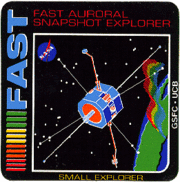 Illustration of FAST | |||||||||||
| Names | Explorer-70, SMEX-2 | ||||||||||
|---|---|---|---|---|---|---|---|---|---|---|---|
| Mission type | Auroral plasma physics | ||||||||||
| Operator | NASA / Goddard Space Sciences Laboratory | ||||||||||
| COSPAR ID | 1996-049A | ||||||||||
| SATCAT no. | 24285 | ||||||||||
| Website | http://sprg.ssl.berkeley.edu/fast/ | ||||||||||
| Mission duration | Planned: 1 year[1] Final: 12 years, 8 months, 9 days[2] | ||||||||||
| Spacecraft properties | |||||||||||
| Manufacturer | NASA / Goddard | ||||||||||
| Launch mass | 191.3 kg (421.7 lb)[3] | ||||||||||
| Payload mass | 65.3 kg (144.0 lb)[3] | ||||||||||
| Dimensions | 1.02 × 0.93 m (3.3 × 3.1 ft)[1] | ||||||||||
| Power | 52 W[4] | ||||||||||
| Start of mission | |||||||||||
| Launch date | August 21, 1996, 09:47 UTC | ||||||||||
| Rocket | Pegasus XL | ||||||||||
| Launch site | Stargazer Vandenberg AFB, California, U.S. | ||||||||||
| Contractor | Orbital Sciences | ||||||||||
| End of mission | |||||||||||
| Disposal | Decommissioned | ||||||||||
| Deactivated | May 1, 2009[2] | ||||||||||
| Orbital parameters | |||||||||||
| Reference system | Geocentric | ||||||||||
| Regime | Low Earth | ||||||||||
| Semi-major axis | 8,300.4 km (5,157.6 mi) | ||||||||||
| Eccentricity | 0.1898 | ||||||||||
| Perigee altitude | 346.8 km (215.5 mi) | ||||||||||
| Apogee altitude | 3,497.8 km (2,173.4 mi) | ||||||||||
| Inclination | 82.9680° | ||||||||||
| Period | 125.4333 min | ||||||||||
| RAAN | 340.7268° | ||||||||||
| Argument of perigee | 109.0590° | ||||||||||
| Mean anomaly | 272.4924° | ||||||||||
| Mean motion | 11.4802 rev/day | ||||||||||
| Epoch | September 5, 2015, 03:48:35 UTC[5] | ||||||||||
| |||||||||||
 Small Explorer program | |||||||||||
The Fast Auroral Snapshot Explorer (FAST) was a NASA plasma physics satellite, and was the second spacecraft in the Small Explorer program. It was launched on August 21, 1996, from Vandenberg Air Force Base aboard a Pegasus XL rocket. The spacecraft was designed and built by NASA's Goddard Space Flight Center. Flight operations were handled by Goddard for the first three years, and thereafter were transferred to the University of California, Berkeley's Space Sciences Laboratory.[3]
FAST was designed to observe and measure the plasma physics of the auroral phenomena which occur around both of Earth's poles.[6] While its Electric Field Experiment failed around 2002, all other instruments continued to operate normally until science operations were ended on May 1, 2009.[2] Various engineering tests were conducted afterward.[2]
Instruments
- Electrostatic Analyzers (ESA): measured electron and ion distribution[6]
- Time-of-flight Energy Angle Mass Spectrograph (TEAMS): measured three-dimensional distribution of major ion species[6]
- Tri-Axial Fluxgate and Search-coil Magnetometers: measured magnetic field data[6]
- Electric Field and Langmuir Probe Experiment: measured electric field data, plasma density and temperature[6]
See also
- Auroral kilometric radiation
- Interbol
References
- ^ a b "FAST Facts". University of California, Berkeley. Retrieved September 5, 2015.
- ^ a b c d "News & Events". FAST Education and Public Outreach. University of California, Berkeley. Retrieved September 5, 2015.
- ^ a b c Pfaff, R.; et al. (August 2001). "An Overview of the Fast Auroral SnapshoT (FAST) Satellite" (PDF). Space Science Reviews. 98 (1/2): 1–32. Bibcode:2001SSRv...98....1P. doi:10.1023/A:1013187826070.
- ^ "Fast Auroral Snapshot Explorer". Goddard Space Flight Center. Archived from the original on June 8, 2012.
- ^ "FAST - Orbit". Heavens Above. September 5, 2015. Retrieved September 5, 2015.
- ^ a b c d e "FAST". National Space Science Data Center. NASA. Retrieved September 5, 2015.
External links
![]() Media related to FAST at Wikimedia Commons
Media related to FAST at Wikimedia Commons
- FAST website by the University of California Berkeley
- FAST Education & Public Outreach website
- FAST website by NASA's Science Mission Directorate
- FAST website (archived) by NASA's Goddard Space Flight Center